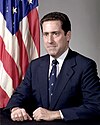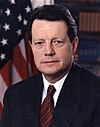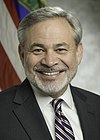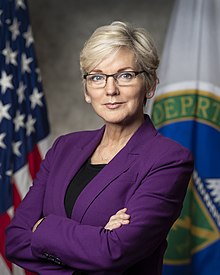The United States secretary of energy is the head of the United States Department of Energy, a member of the Cabinet of the United States, and fifteenth in the presidential line of succession. The position was created on October 1, 1977, when President Jimmy Carter signed the Department of Energy Organization Act, establishing the department.[2] The energy secretary and the department originally focused on energy production and regulation. The emphasis soon shifted to developing technology for better and more efficient energy sources, as well as energy education. After the end of the Cold War, the department's attention also turned toward radioactive waste disposal and the maintenance of environmental quality.[3] Former secretary of defense James Schlesinger served as the first secretary of energy. As a Republican nominated to the post by Democratic president Jimmy Carter, Schlesinger's appointment marks the only time a president has chosen a member of another political party for the position. Schlesinger is also the only secretary to be dismissed from the post.[4] Hazel O'Leary, Bill Clinton's first secretary of energy, was the first female and first African American to hold the position.[5] The first Hispanic to serve as Energy Secretary was Clinton's second energy secretary, Federico Peña.[6] Spencer Abraham became the first Arab American to hold the position on January 20, 2001, serving under the administration of George W. Bush. Steven Chu became the first Asian American to hold the position on January 20, 2009, serving under president Barack Obama. Chu was also the longest-serving secretary of energy and the first individual to join the Cabinet after having received a Nobel Prize.[7]
| United States Secretary of Energy | |
|---|---|
 Seal of the department | |
 Flag of the secretary | |
| United States Department of Energy | |
| Style | Madam Secretary (informal) The Honorable (formal) |
| Member of | United States Cabinet United States National Security Council |
| Reports to | President of the United States |
| Seat | James V. Forrestal Building, Washington, D.C. |
| Appointer | The President of the United States with Senate advice and consent |
| Term length | No fixed term |
| Constituting instrument | 42 U.S.C. § 7131 |
| Formation | August 6, 1977 |
| First holder | James R. Schlesinger |
| Succession | Fifteenth[1] |
| Deputy | Deputy Secretary |
| Salary | Executive Schedule, level I |
| Website | Energy.gov |
President Joe Biden's nominee to be Secretary of Energy, former Michigan governor Jennifer Granholm, was confirmed on February 25, 2021. Granholm is the second woman to lead the Department of Energy.[8]
Nuclear weapons
In addition to responsibilities related to generation and use of energy, the secretary is the most senior official other than the president of the United States or Secretary of Defense with primary responsibility for the nation's ~3,800 viable nuclear weapons. This arrangement is intended to maintain full civilian control over strategic weapons, except as directed by the president for specific military uses.[citation needed] The department of energy is responsible for the building, maintenance, and disposal of all nuclear weapons within the United States' arsenal in addition to safeguarding these weapons when they are not actively deployed in military service. Under the terms of several successive treaties, most recently New START, the United States has reduced its strategic arsenal to 1500 deployed weapons. Consequently, many older legacy weapons systems have been dismantled or scheduled for dismantlement, with their core radioactive fuel - generally plutonium - being reprocessed into reactor-grade or space exploration fuel.[citation needed]
List of secretaries of energy
- Parties
Democratic (7) Republican (9)[citation needed]
Status
Acting Secretary of Energy
| No. | Portrait | Name | State of residence | Took office | Left office | Party | President(s) | |
|---|---|---|---|---|---|---|---|---|
| 1 |  | James Schlesinger | Virginia | August 6, 1977 | August 23, 1979 | Republican | Jimmy Carter | |
| 2 |  | Charles Duncan | Texas | August 24, 1979 | January 20, 1981 | Democratic | ||
| 3 |  | James Edwards | South Carolina | January 23, 1981 | November 5, 1982 | Republican | Ronald Reagan | |
| 4 |  | Donald Hodel | Oregon | November 5, 1982 | February 7, 1985 | Republican | ||
| 5 |  | John Herrington | California | February 7, 1985 | January 20, 1989 | Republican | ||
| 6 |  | James Watkins | California | March 1, 1989 | January 20, 1993 | Republican | George H. W. Bush | |
| 7 |  | Hazel O'Leary | Virginia | January 22, 1993 | January 20, 1997 | Democratic | Bill Clinton | |
| – |  | Charles B. Curtis | Pennsylvania | January 20, 1997 | March 12, 1997 | Democratic | ||
| 8 |  | Federico Peña | Colorado | March 12, 1997 | June 30, 1998 | Democratic | ||
| 9 |  | Bill Richardson | New Mexico | August 18, 1998 | January 20, 2001 | Democratic | ||
| 10 |  | Spencer Abraham | Michigan | January 20, 2001 | February 1, 2005 | Republican | George W. Bush | |
| 11 |  | Samuel Bodman | Illinois | February 1, 2005 | January 20, 2009 | Republican | ||
| 12 |  | Steven Chu | California | January 20, 2009 | April 22, 2013 | Democratic | Barack Obama | |
| – |  | Daniel Poneman | Ohio | April 22, 2013 | May 21, 2013 | Democratic | ||
| 13 |  | Ernest Moniz | Massachusetts | May 21, 2013 | January 20, 2017 | Democratic | ||
| – |  | Grace Bochenek | January 20, 2017 | March 2, 2017 | Donald Trump | |||
| 14 |  | Rick Perry | Texas | March 2, 2017 | December 1, 2019 | Republican | ||
| 15 |  | Dan Brouillette | Texas | December 1, 2019 | December 4, 2019 | Republican | ||
| December 4, 2019 | January 20, 2021 | |||||||
| – |  | David Huizenga | January 20, 2021 | February 25, 2021 | Democratic | Joe Biden | ||
| 16 |  | Jennifer Granholm | Michigan | February 25, 2021 | Incumbent | Democratic | ||
